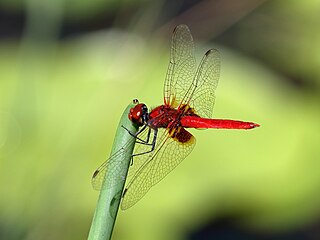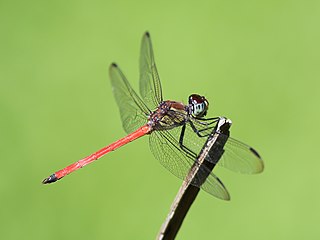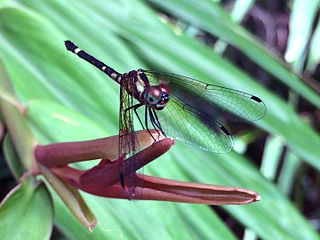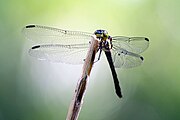
The Gomphidae are a family of dragonflies commonly referred to as clubtails or club-tailed dragonflies. The family contains about 90 genera and 900 species found across North and South America, Europe, Asia, and Australia. The name refers to the club-like widening of the end of the abdomen. However, this club is usually less pronounced in females and is entirely absent in some species.

Tramea is a genus of dragonflies in the family Libellulidae, the skimmers and perchers. Species of Tramea are found in tropical and subtropical regions around the globe. They typically have colored bases to their otherwise translucent hindwings. In particular when they fly, this creates the impression of their carrying bags at the start of their abdomens. They are known commonly as saddlebags or saddlebags gliders.

The common flatwing is a very common species of damselfly of the subfamily Argiolestinae in the family Megapodagrionidae. It is also known as an Australian flatwing.

The orange threadtail or ochre threadtail is an Australian damselfly in the family Platycnemididae. They are medium-sized with a length of around 35mm. Orange threadtails can be found near semi-shaded running water, and usually rest on plants at the water's edge. Orange threadtails may be seen all year round. In Victoria they occur at lower altitudes during summer, though further north they can be seen in spring and autumn. When at rest, Nososticta damselflies hold their wings closely folded up vertically over their thorax. The male threadtails have an orange-yellow thorax with black patterns. Their abdomen is narrow, black in colour with yellow strips. There is a brown yellow colour at the base of their wings. Females are the same size as the males. They are pale brown in colour and have the same black patterns as the males.

Prodasineura verticalis is a damselfly in the family Platycnemididae. It is commonly known as the red-striped black bambootail or black bambootail.

Agrionoptera is a genus of dragonflies in the family Libellulidae. Species of Agrionoptera are found across India, Southeast Asia and the Pacific.

The tau emerald is a species of dragonfly in the family Corduliidae. It is found in all parts of Australia except northern Queensland and north-western Western Australia. The species was first described by Edmond de Sélys Longchamps in 1871.

Rhyothemis resplendens, common name Jewel flutterer, is a species of dragonfly in the family Libellulidae. The genus Rhyothemis extends from Africa to the western Pacific, with five species known in Australia. The species Rhyothemis resplendens has blue metallic reflecting panels on both wing sets, and inhabits streams, rivers and still waters on and adjacent to coastal Queensland, from around Mackay to the northern part of Cape York Peninsula. It is a small dragonfly with a wingspan of 40-60mm and body length around 25mm. To the north of Australia it is found in the Moluccas, New Guinea and the Bismarck Archipelago. On the adult, markings on the hindwing are longer than those on the forewing. The taxon has been assessed for the IUCN Red List as being of least concern.

Rhyothemis graphiptera, known as the graphic flutterer or banded flutterer, is a species of dragonfly of the family Libellulidae. It is found across northern Australia, the Moluccas, New Guinea and New Caledonia. Rhyothemis extends from Africa to the western Pacific.

Aethriamanta circumsignata known as the square-spot basker is a species of dragonfly in the family Libellulidae. It is found in Australia, and New Guinea. The species is usually found near still or sluggish waters.

Lathrecista asiatica festa known as the Australasian slimwing is a sub-species of Lathrecista asiatica, a dragonfly in the Libellulidae family, found only in Australia. Its range is coastal and adjacent inland in an arc from the Northern Territory to the southern Queensland border. It is a medium-sized dragonfly with a wingspan of 60-85mm, and is usually near rivers, streams, swamps and lagoons but at times can be far from water. The male has a black and yellow thorax with brown upper parts, and a reddish-orange abdomen with a black tip. The taxon has not yet been assessed for the IUCN Red List.

Ictinogomphus australis, known as the Australian tiger, is a species of dragonfly in the family Lindeniidae, which was formerly part of the family Gomphidae. It is found near rivers, lagoons, lakes and ponds. They are large dragonflies with eyes widely spaced on top of the head. They have clear wings and are yellow and black in colour. The males are identified from females by two curved flaps below segment eight of the abdomen. They are found in an arc ranging from about Broome, Western Australia along the north of the continent to Point Hicks on the south-east corner. The taxon has been assessed for the IUCN Red List as being of least concern.

Urothemis aliena, commonly called the red baron, is a species of dragonfly found in northern and eastern Australia and New Guinea. It is a member of the family Libellulidae. It inhabits riverine lagoons and ponds.

Agrionoptera insignis allogenes known as the red swampdragon is a subspecies of dragonfly in the family Libellulidae. It is found in Australia, New Guinea, the Solomon Islands and possibly New Caledonia.

Agrionoptera insignis is a species of dragonfly in the family Libellulidae. It is native to much of eastern Asia and Oceania, occurring as far north as Japan and as far south as Australia. It is common in most of its range. The circumscription of the species is not entirely clear, so if the species is rediscribed, its status may change. Common names include grenadier.

Agrionoptera longitudinalis is a species of dragonfly in the family Libellulidae.

Austroaeschna speciosa is a species of dragonfly in the family Telephlebiidae, known as the tropical unicorn darner. It is known to be present only in the mountainous regions of north-east Queensland, Australia. It appears very similar to the more widespread Austroaeschna unicornis which inhabits areas in southern Queensland, New South Wales, Victoria and Tasmania.

Tramea eurybia is a species of dragonfly in the family Libellulidae, known as the dune glider. It inhabits still waters on the Andaman Islands, Sumatra, Sulawesi, the Maluku Islands, New Guinea and Fiji; and can be found at dune lakes in eastern Australia. It is a medium-sized dragonfly with red, brown and black markings and a distinctive dark patch at the base of the hindwing.

Tetrathemis irregularis cladophila known as the rainforest elf is a subspecies of Tetrathemis irregularis, a dragonfly in the family Libellulidae found only in Australia.






















